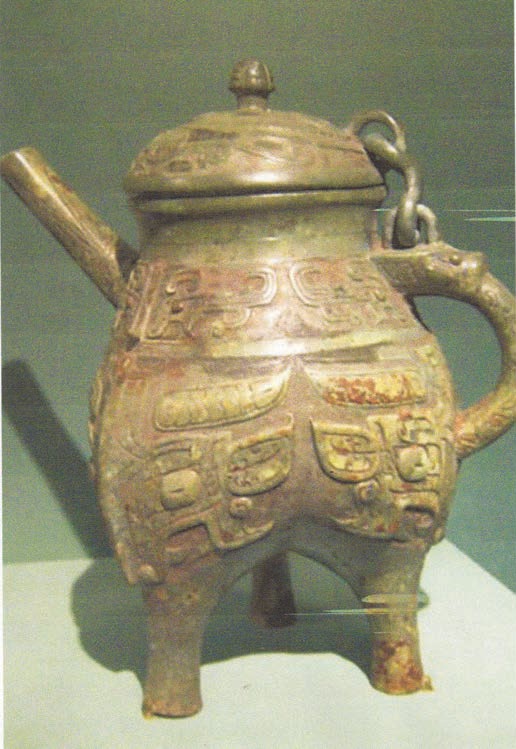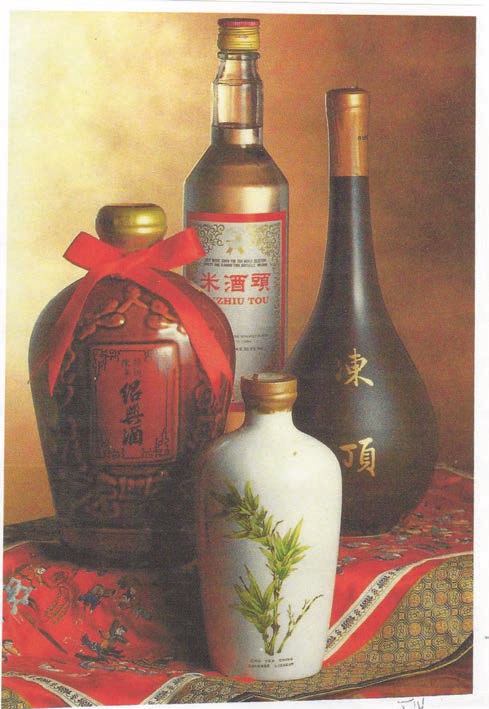
| What is Flavor and Fortune? |
| How do I subscribe? |
| How do I get past issues? |
| How do I advertise? |
| How do I contact the editor? |
Read 12956090 times
Connect me to:
| Home |
| Articles |
| Book reviews |
| Letters to the Editor |
| Newmans News and Notes |
| Recipes |
| Restaurant reviews |
| Article Index (all years, slow) |
| List of Article Years |
| Article Index (2025) |
| Article Index (last 2 years) |
| Things others say |
| Related Links |
| Log In... |
| Authors |
| Categories & Topics |
Jiu: Alcoholic Beverages Past and Present
| by Jacqueline M. Newman |
Beverages
Summer Volume: 2018 Issue: 25(2) pages: 30 to 32
Many a Shaman used these mind-altering liquids to induce trances, some told us they worked even with very little alcohol, but did work better with a reasonable amount. Jiu was known during Shen Nong times, is the word used for all wines a couple of thousand years ago and often still is. Most were made from plant ingredients. We did and still call them wines no matter their alcohol content. These days, in many countries, they have specific amounts of alcohol, usually twelve to fourteen percent; not so in China. There, very few tell their specific alcoholic content on their label.
A few very old alcoholic beverages were found in bronze and other containers in China, unearthed in ancient tombs. They were perfectly preserved with a little or a lot of jiu in them. Some were dated from earlier times than were Roman finds recovered from shipwrecks in the Mediterranean Sea. Many were amazed to find them there and in drinkable condition. We were told that the Chinese ones were ‘amazing’, but in what ways, we know not.

Some in the bronze containers were probably used for ceremonial purposes, others perhaps simply for imbibing. The containers were of various shapes, some were dings, others were zeng, xian, fu, zun, you, hu, jiao, or items known by other names. Drinking etiquette then was written about some used for worship, sacrifices, or simply for sampling.
One anthropology professor told us very few were used for guzzling, and then only if one’s partner downed his first in that manner. In The Book of Rites, one can read of not daring to drink until elders finished theirs first or one had to pay a penalty. But what that was we never learned. There was also a close relationship between jiu and politics;. Government leaders used different patterns of imbibing if leaders or ordinary folk, these specifics we know not, as well.
Jiu was and still can be the word the Chinese use for most beverages made from fermented items such as millet, wheat, hops and others. If made from grapes or other fruits, other words were and are more common. Making them was a straight-forward process thanks to the yeasts found on their skins. Since the Dawnkou culture (circa 4,300 - 2,400 BCE), the Chinese made pottery containers to hold them (As seen in this ceramic but metallic-looking container). Those from cereals such as rice can need more sophisticated technology to ferment their sugars, yeasts, malts, molds, and other items. Even saliva can be and was used; it has the enzyme ptyalin and it can do that job, too.
Beer, made from cereal grains, uses malt or hops to do the same job, and has since earliest times. Common people drank it or jiu on holidays and festivals, maybe even when entertaining guests at home or when eating out. They may have enjoyed Maotai, Fenjiu, Wulianye, Jiannanchun, Gujingbaojiu, Yanghedaqu, Dongjiu, Luzhoulaojiaotequ, Xinfengjiu, or Quanxingdauqu.
Maotai, once known as the ‘Glory of China’, did originate in the town of that name in Renhuai County in the Guizhou Province. We learned it was and is popular; also usually stored for three years before making it to market. Others such as Fengjiu comes from the Apricot Flower Village in Fen Yang County in the Shanxi Province. Wuliangyu, was and is also popular. It is made and named for its five cereals. They are ordinary rice, glutinous rice, sorghum, maize, and wheat. It is made in Yibin City in the south of the Sichuan Province. Luzhoulaojiaotequ originally was only made in Luzhou City in the Sichuan Province. Now some can also be made elsewhere.
Rice wines are very old Chinese alcoholic beverages, the most famous is probably Shao Xing, made in that city in the Zhejiang Province. We did visit their wine museum and photographed one wall there,. We learned it is enjoyed when cooking, seasoning, drinking, and preparing Chinese medicines such as pills, powders, and liquids.

Chinese TCM folk tell us these alcoholic beverages and things made from them can improve qi, blood circulation, and good health, and they can protect vital organs, keep the skin in good shape, warm and revitalize the body, assist digestion, disinfect, and be used when making many medicinal decoctions. They also said they can be given to new mothers post-partum and during the confinement month; and that many are made with cooked, steamed, or raw rice among other things. They said the grains usually disappear becoming liquid, though some are best with strained to remove their sediment before storing and consuming them.
Most grape wines come from China’s northeast, the best can be red or look brownish. Others come from Beijing, or Tonghua in the Jilin Province where they also make brandies. A few bottles of different jiu products are shown with this article. Some may originate in Yantai in the Shandong Province. A popular one is Zhuyeqing, in English it is known as bamboo leaf liquor, and is sweet and often greenish- golden in color.
Tonic wines have a long history in China. Some were made during the Xia Dynasty (21st - 11th centuries BCE). We know that because their names were inscribed on turtle shells and animal bones dated from those times. Some are made today and the same ways using the same Chinese herbs. These include matrimony berries, ginseng, Fructus schizandrar or haw fruit and are made just as they were hundreds or thousands of years ago. Some include newer Chinese medicines, and all are touted to help cure various diseases and promote good health.
According to ancient historical records, eight different items were written about as necessary for life. These included jiu, firewood, rice, oil, salt, sauce, vinegar, and tea. However, jiu was removed from this list during the Yuan Dynasty when rulers deemed all not needed daily. This left just seven necessities for life, and you can figure out what they were.
During the Shang Dynasty (1600 - 1122 BCE), bronze and other ritual containers were made for the alcoholic beverages they called yi, jue, jia, hu, zun, gu, you, or doushao. During the Spring and Autumn Period (722 - 481 CE), Confucius did describe ritual use when he edited the Li Ji or the ancient Book of Rites.
Dated from the Warring States Period (475 - 221 BCE), he also describes erbai which are ‘ear cups’ recently found at Mawangduei in the Hunan Province. Emperor Wudi’s (141 - 87 BCE) had a first minister, Zhang Qian, who did go to Afghanistan circa 138 BCE, and on his return did introduce grapes and grape wines to China. Then and since, yellow, green, blue, purple, red, and clear ones have become popular.
Do you know the names or alcoholic contents of any of them?
Drinking wine and other alcoholic beverages are important parts of China’s social fabric. We know quite a lot about them from the unearthed empty or near empty containers found. These days, the Chinese still drink them and they use similar ones to tenderize meat, remove fishy flavors and aromas, and add them to many dishes to enhance their taste. Do you use them? They also use moderate amounts of these alcoholic beverages for their health; do you do that too? These are just some of the reasons their popularity has grown.
We also know that some alcoholic beverages were and are made with barley or rice and called li. Some were and are made with beans or wheat and called jiang. Since antiquity, the Chinese have been fermenting many different grains, hops, fruit juices, and more. They still use them for these beverages, for flavorings, medicines, aromatics, and more.
Not all Chinese are heavy drinkers; though some are. We read about drinking parties in the past, drunken brawls then and now. Ghenghis Khan once urged his people not to drink so much. He said it would damage their spirit and reduce their longevity. He knew that the Mongols were heavy drinkers. Did you know that?
The Chinese believe the nature of wine and other alcoholic beverages are hot; and that beer is not; it is they say, cold. Shang Dynasty oracle bones (circa 1765 - 1122 BCE), predict many uses of alcohol. They and we enjoy these beverages plain and in many Chinese recipes;. Do you? We hope you will try some of those provided below.
| Drunken Chicken |
|---|
1 Tablespoon fresh ginger, smashed
1. Bring two quarts cold water in a wok or four quart pot, add the chicken pieces, ginger, and the scallions, cover the wok or pot, turn off the heat, and let these items rest for fifteen minutes. Reserve two cups of the
hot water and put this into the rinsed pot.
|
| Belly Pork, Drunken Style |
|---|
2 cups total (1//4 cup each, of the following eight ingredients: raw peanuts, dried red beans, chopped nuts, rock sugar, slivered almonds, dried longans, small raisons, and gogi berries)
1. Soak each of the eight items in separate bowls overnight, then drain each and simmer each separately for twenty minutes, then drain each one and allow them to cool before mixing them together. 2. Cook half the rice about half an hour or until thick, then add the other half and cook ten minutes. 3. Then add the eight cooked ingredients, and serve hot or warm, or freeze. |
| Rice Balls in Sweet Wine |
|---|
2 Tablespoons goji berries, separated
1. Soften the goji berries in warm water for twenty
minutes, drain, then divide in half, and cut one half of
them n half.
|

Copyright © 1994-2025 by ISACC, all rights reserved
Address
3 Jefferson Ferry Drive
S. Setauket NY 11720